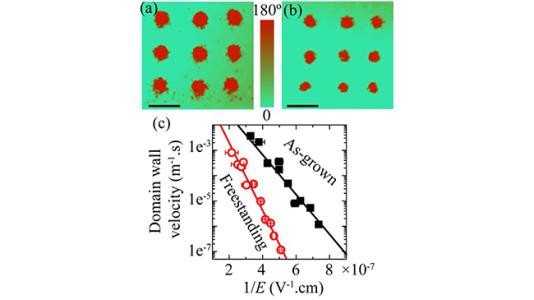
Scientific Achievement
Scanning probe microscopy reveals a drastic reduction of domain wall velocity in single-crystal complex oxides when interfacial bonds with the heteroepitaxial substrate are broken, to create a freestanding thin film.
Significance and Impact
We shed the first light on the local energy landscape and domain wall dynamics in mechanical boundary-free complex oxide layers. This will help to understand the intrinsic dynamic properties of complex oxides.
Research Details
-
We created freestanding layers of epitaxial PbZr0.2Ti0.8O3 (0.4-100 nm thick) using a selective wet etching technique.
- We performed piezoresponse, electrostatic force and microwave impedance microscopy to probe domain wall motion, width and roughness, local capacitance and surface polarization. Results are explained by flexoelectric effects due to nanoscale ripples in freestanding films, as evidenced by atomic force microscopy and hard x-ray nanoprobe studies.
About Argonne’s Center for Nanoscale Materials
The Center for Nanoscale Materials is one of the five DOE Nanoscale Science Research Centers, premier national user facilities for interdisciplinary research at the nanoscale supported by the DOE Office of Science. Together the NSRCs comprise a suite of complementary facilities that provide researchers with state-of-the-art capabilities to fabricate, process, characterize and model nanoscale materials, and constitute the largest infrastructure investment of the National Nanotechnology Initiative. The NSRCs are located at DOE’s Argonne, Brookhaven, Lawrence Berkeley, Oak Ridge, Sandia and Los Alamos National Laboratories. For more information about the DOE NSRCs, please visit https://science.osti.gov/User-Facilities/User-Facilities-at-a-Glance.
Argonne National Laboratory seeks solutions to pressing national problems in science and technology. The nation’s first national laboratory, Argonne conducts leading-edge basic and applied scientific research in virtually every scientific discipline. Argonne researchers work closely with researchers from hundreds of companies, universities, and federal, state and municipal agencies to help them solve their specific problems, advance America’s scientific leadership and prepare the nation for a better future. With employees from more than 60 nations, Argonne is managed by UChicago Argonne, LLC for the U.S. Department of Energy’s Office of Science.
The U.S. Department of Energy’s Office of Science is the single largest supporter of basic research in the physical sciences in the United States and is working to address some of the most pressing challenges of our time. For more information, visit https://energy.gov/science.